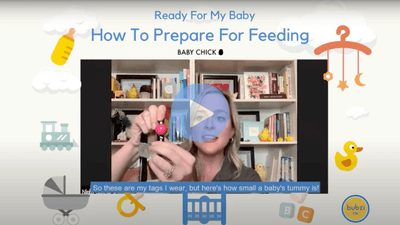Going from exclusively breastfeeding or bottle feeding to eating solids can be a big deal for both parents and their little ones. Suddenly your infant, who survived only on liquids for months, is now interested in solid food! That’s why starting solids can be an adventure for both of you and your little one. We’ve created an easy to follow timeline of when to introduce certain foods by age (month by month) to make the whole process that much easier for you. We’ve also included some tips to help you get started. Read on to discover our top baby food guidelines to help your baby develop a lifetime of healthy eating habits!

Easy Tips for Baby Led Weaning: Baby Food Guidelines For The First Year
Before you start
Before you start planning your baby’s meals, be aware there are certain foods you should avoid until your little one is at least 1 year old.
- Honey - can cause infant botulism
- Whole milk – can be hard for babies to digest
- Grapes – due to their size they can be choking hazards
- Nuts - are a common allergy
- Candy - can cause tooth decay and depending on what it is, can be a choking hazard

When to start introducing solids
From the time that baby is born to when they are around 6 months old, breast milk or infant formula is all the nourishment they need. Hold off on the cow’s milk or other dairy products until baby is at least 1 year old. The high protein and mineral content can be difficult for their kidneys to handle. Once baby is 6 months old, look for these signs to help you decide if your little one is ready for solids:
- Can sit upright and hold up their head
- Is curious, looking at everything around them (especially when you’re eating)
- Has mastered tongue movement
- Seems hungry even after getting a full day’s portion of milk (eight to 10 breastfeedings or 18-32 oz. of formula.

Babies who are 6 months old
At this stage, the majority of baby’s nutritional needs should be met with breast milk or formula only. This is more of a discovery time for solid foods as babies at this age don’t have the skills to chew and/or swallow food properly. Allow your baby to try a variety of foods as purees. If you’re worried about potential food allergies, introduce common allergen foods one at a time and wait at least 4 days to see if your baby has an allergic reaction. Once a food has been introduced, try mixing it in combination with other fruits, veggies and cereals.
Daily serving of breast milk or instant formula: 28-40 ounces
New foods to introduce:
- cereals & grains: rice, barley, oats
- fruits: apples, pears, avocado, banana
- vegetables: butternut squash, sweet potatoes, green beans
Baby food tips:
- Although great first foods, avocado & banana do not freeze well. Instead introduce these two foods to your baby fresh – just mash and add breast milk or water to create a puree.
- Salt and sugar should never be introduced to be a baby in the first year.

Babies between 6-8 months old
Once baby has hit the 6 to 8 month mark, they are ready to try a larger variety of pureed and strained fruits and vegetables, pureed meat and beans, yogurt (wait until 8 months) and cereal. It’s important to continue to give breastmilk or formula as their primary source of nutrition.
Breast milk or instant formula: 24-36 ounces
New foods to introduce:
- cereals & grains: rice, barley, oats
- fruits: apples, pears, peaches, plums, nectarines, prunes, pumpkin, apricot, avocado, banana
- vegetables: butternut squash, sweet potatoes, green beans, carrots, peas, zucchini, parsnips, potato
- protein: chicken, turkey, tofu
- dairy: plain whole milk yogurt (avoid anything with added sugars)
Foods to avoid: Wait until baby is at least 7 months before you introduce yogurt into their diet.

Babies between 8-10 months old
This is the time when you can start reducing the amount of breastmilk and/or formula your baby has in a day. The amount of solids being eaten should increase and stage 2 foods that have more texture can be introduced. These are foods that are either mashed or pulsed and give your little one the opportunity to start chewing and discovering food. Small chunks of raw, soft fruit and cooked vegetables are great finger foods for baby and give them the opportunity to learn how to feed themselves. Iron is an important nutrient for baby at this stage, so make sure they are getting at least 1 serving of an iron fortified cereal and a protein a day.
New foods to introduce:
- cereals & grains: buckwheat, flax, well cooked pasta, quinoa
- fruits: blueberries, cantaloupe, cranberries, figs, grapes (cut in quarters), kiwi, papaya
- vegetables: asparagus, broccoli, beets, cauliflower, eggplant, onion, peppers, potato
- meats & protein: beef, scrambled eggs, boneless fish, pork, beans/legumes
- dairy: hard cheese (cheddar, jack, Colby), cottage cheese, cream cheese, plain whole milk yogurt (with no added sugars).
Baby food tips: Most fruits can now be served raw – just make sure you grate them or cut them into small pieces before giving them to baby.
Babies between 10 to 12 months
Now that your baby is nearing their 1 year milestone birthday, it is time for them to get nearly all of their nutrients from solids. Your baby might not enjoy eating solids at first, so make sure you take it slow and try a food more than once before giving up on it completely. It is best to serve your baby a version of what you are eating, except that it should be mashed, chopped or diced into small pieces. It’s easier to feed your baby the same thing as the rest of the family rather than making them a separate meal all together. Allow your baby to feed themselves at this stage by including finger foods and soft, raw fruits/vegetables with their meal.
Breast milk or instant formula for 10-12 months: 18-30 ounces
New foods to introduce:
- cereals & grains: mac & cheese
- fruits: any berry & citrus
- vegetables: corn, cucumbers, spinach/green leafy vegetables, tomatoes
- protein: whole eggs
- dairy: whole milk their drink & soft cheeses after 12 months
Knowing when to start your baby on solids (and what kind to introduce) can be a stressful process. The key is to go slow and add in foods one at a time so as not to overwhelm your baby (or their digestive system)! It’s important that parents start developing healthy eating habits with their baby right from the first taste of solid food. And keep in mind that breastfeeding and/or formula feeding is still important for your little one until they reach at least age 1. Follow the baby food guidelines and tips above to successfully take your little one from a liquid diet to starting solids!
Before long your baby will go from tiny infant to little toddler, eating solid meals and running around the house. Preserve that moment in time when your baby is just little and starting out in the world. Bubzi Co.'s DIY Baby Handprint and Footprint Ink Frame or Clay Frame is the perfect way to capture the moment. The frames are a fun DIY project that allow you to make an impression of your baby’s hand and feet. Because, as we know, babies change and grow so fast - they’re only little for so long!









